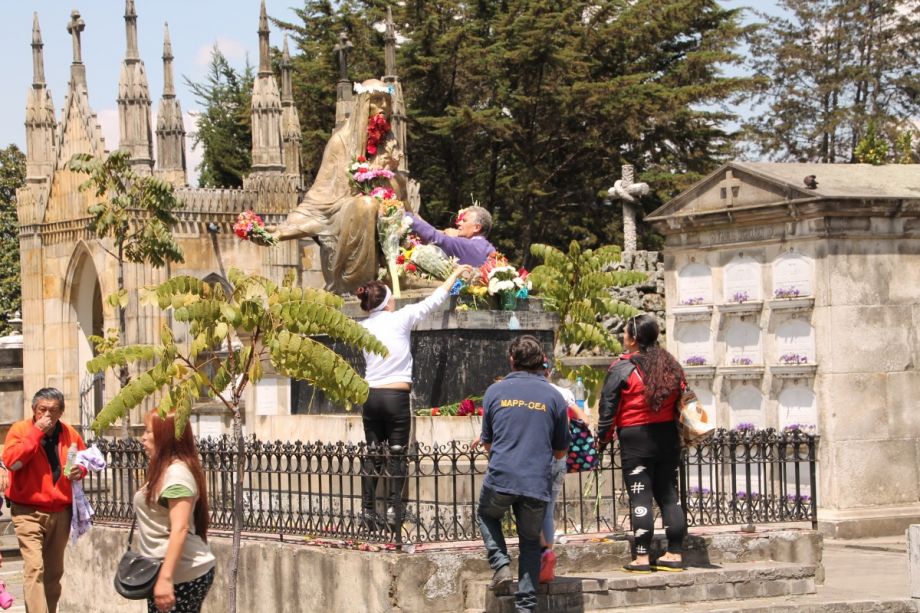We say prayers over our dead as we lower them into the graves. We cover their tombs with stones into which we engrave holy symbols. These solemn rituals can seem starkly quiet in an urban cemetery surrounded by the noises of city life, and as data-crunchers and economists study the effects of rapid urbanization, such sacred spaces may seem an anomaly. Yet it’s in burial places that Dutch anthropologist Christien Klaufus finds clues to how urban development impacts all of us.
As governments scramble for efficient solutions to house the dead, private companies raise rents on prime graveyard plots. And, as in cities around the world, the poor are relegated to the periphery — in the form of mass exhumations and cremations. The story of the dead in the city mimics a gentrification that as Klaufus puts it, “deepens inequalities between those who are allowed to ‘rest in peace’ and those who are to be recycled.”
Klaufus’ new study, which focused on cemeteries in Colombia’s metropolises, takes both the micro and macro lens to this infinitely delicate issue. She looks at the context of global patterns of urbanization, national policies and municipal planning, all the way down to the intricacies of just how cemeteries are used on a daily basis by different sectors of the population.
Her research strategy, in the interest of delicacy, mirrored this macro-to-micro approach. “I didn’t start with the people that were burying someone,” she explains. Instead, she started with the government workers in the unit in charge of the cemeteries. From there, she started to go to the cemeteries every day. She talked to the employees working there, and to the flower vendors, and to the stonecutters. She observed funerals. And then she finally started talking to people visiting.
That doesn’t necessarily mean she spoke to the bereaved. Cemeteries in Latin America “are a completely different setting than in the States or Europe,” she explains, “because they have so many more uses.” They are places people go, Klaufus explains, to “negotiate with death.” She describes a rich ecosystem of cemetery inhabitants and how many people go to cemeteries to visit specific graves of people they believe are lost souls. People line up to pray near specific folk saints’ graves too.
However much a part of the culture, the space is becoming endangered amid the demand for real estate. “More space is needed for the living,” writes Klaufus, “but sufficient spatial capacity is also needed for [the] dead.” Urbanization accelerates and the dead accumulate. In countries like Colombia, which initiated forced migration schemes to spur economic growth, the burden of the dead weighs even greater. By 2020, Bogotá will have 9.1 million residents and 40,000 annual corpses. This will mean an average daily demand of 113 plots or tombs.
At recent protests against the stench of a Bogotá crematorium, residents carried signs of desperation: “The dead are killing the living.” And, Klaufus points out, they’re also reproducing the living’s spatial patterns of inequality. “I never expected cemeteries to be so fully segregated,” she says.
In Bogotá’s first out-of-town cemeteries, the aristocratic elite constructed statues, mausoleums and chapels in the Cemeterio Central — sections known as ‘Globo A.’ Meanwhile, Globos B and C were reserved for the smaller, shallower plots for the lower classes, and — following mid-century violence in the capital — the mass graves of anonymous dead.
Today, death is more about industry than dignity — and that industry is booming. The death industry in Colombia grew by 15 percent every year between 2010 and 2013, producing millions of dollars for private companies. The majority of crematoria are privately owned and cremation rates skyrocket for two reasons: It costs a fraction of burial, and bodies in cheaper plots must be exhumed after four years. After that families must re-identify the bodies and figure out what to do with them. So of course, there’s also the business of selling space to store the ashes (in spaces that are also stratified by spatial pricing structures). Often, poor families cannot afford — or bear — to travel to the exhumation and re-identify the remains of the bodies of their loved ones so cemeteries commonly sell them.
Colombia’s government has sought to regulate this economy with citywide master plans that aim to create new spaces to house the dead and new facilities to embalm them. But economic support has done little to reverse the broader trend of the death industry: the erasure of the poor and the enshrinement of the wealthy.
In the 1990s, Bogotá Mayor Enrique Peñalosa closed Globo C to make way for a public park. Not long after, Globo B closed to make way for a monument. Thousands of lower-class bodies were removed without ceremony. Meanwhile, the wealthier Globo A — like so many upscale cemeteries worldwide — has transformed into a tourist destination. The gravestones, vaults and mausolea become city monuments. Security guards patrol their perimeter. Sound familiar?
The dead in the global city play by the same rules as the living. The poor are dumped on the periphery — ashes in an urn — and the wealthy stay protected in gated communities. Also, where the wealthy lie still, the poor keep moving — into smaller and smaller boxes, or larger mass graves and landfills.
We like to conceive of life after death as eternity. But Klaufus reminds us that in this hyper-capitalist world, even eternity is a commodity. The wealthy rest “eternal.” The poor rest “efficient.” And so, “time,” Klaufus concludes, “is on the side of the distinguished families who do not have to worry about exhumation, re-identification or the cremation of their relatives.”
For the rest, the possibility of a more dignified death relies crucially on the fight for more than just master plans of deathscapes. And, Klaufus insists, to make them just, we must consider their daily uses by the living.
The Science of Cities column is made possible with the support of the John D. and Catherine T. MacArthur Foundation.

Zoe Mendelson is a journalist in Mexico City campaigning for a more chiller world. Her work has been featured on Fast Company, Buzzfeed, Untapped Cities and elsewhere.
Follow Zoe .(JavaScript must be enabled to view this email address)









